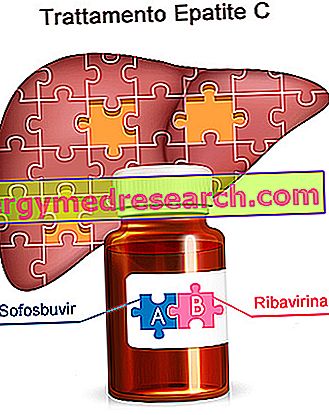Generality
Skin aging is an inevitable biological phenomenon. Fortunately, this is an extremely gradual process, which gives man the ability to get used to the changes in his physical appearance.

In any case, advancing age leads to modifications to all the components of the integumentary system. At the end of growth the skin begins to age, depending on age and individual characteristics.
deepening
Cosmetics against skin aging. Anti-aging cosmetics. Wrinkles and skin aging. Vitamin A and E against premature skin aging. Contrasting skin aging: vitamin C and B3. Hydroxy acids, soft-focus, peptides.Types of Aging
As mentioned, skin aging is a completely natural and inevitable physiological process that affects all individuals.
The structural modifications to which the skin encounters with the passing of time are caused by a series of factors of different origins.
In detail, it can be said that these modifications are caused by two forms of aging:
- Intrinsic - or chronological - aging that substantially depends on genetic (or intrinsic) factors ;
- Extrinsic skin aging - or environmental factors - caused by external factors (extrinsic factors).
Intrinsic aging, in principle, starts after the age of 25 and involves a series of modifications that lead to the thinning and failure of the skin structure.
Extrinsic aging, on the other hand, is caused by the aggression of external agents and environmental factors such as UV radiation (responsible for photo - aging ), cigarette smoking, alcohol abuse, pollution and continuous contact with substances irritating.
Structural alterations
What are the structural changes that occur during skin aging?
Summarizing what has been said so far, we can say that skin aging is a completely natural process linked to genetic (or intrinsic) factors that can, however, be accelerated and accentuated by the action of external (or extrinsic) environmental factors.
The structural modifications suffered by the skin with advancing age involve all its layers: from the most superficial (epidermis) to the deepest (hypodermis).
These changes will be briefly described below.
Epidermis
At the level of the epidermis the proliferative capacity of the basal cells is reduced to which the progressive thinning of this superficial layer follows. This phenomenon therefore leads to a decline in its protective effectiveness.
Also at epidermal level, the number of Langerhans cells is halved, particularly important because they belong to the immune system.
Furthermore, the cutaneous synthesis of vitamin D decreases up to 75%, with a consequent decrease in muscle strength and progressive bone demineralization.
The activity of melanocytes is also reduced and, proportionally to this deficit, the skin becomes more susceptible to the effects of solar radiation and other environmental factors. Also for this reason in the elderly there is an increased incidence of skin cancers.
At the same time, very active melanocyte aggregates can form in mature skin, with consequent appearance of solar lentigo (skin spots in areas exposed to UV rays) and senile lentigo, which can be associated with an increased risk of melanomas.
Dermo-epidermal junction
In a similar way, the structural alterations occur at the expense of the dermo-epidermal junction - also known as the basement membrane - which is located at the border between the epidermis and the papillary dermis.
In fact, due to aging processes, the basement membrane becomes thinner and the interface between epidermis and dermis, which normally has a wavy pattern due to the presence of dermal papillae, tends to flatten out. Consequently, there is less support from the dermis towards the overlying epidermal layer.

Anti-oxidant supplement Antiage X115 + Plus
New generation anti-aging supplement. Double Day & Night formulation with high concentration of assets; supports and optimizes antioxidant defenses and stimulates the synthesis of collagen, hyaluronic acid and elastin . " More information "
Derma
Undoubtedly, the structural alterations suffered by the components of the dermis constitute one of the determining factors that lead to the typical sagging of the aging skin.
In fact, the aforementioned flattening of the dermal papillae and the decrease in support of the dermis against the epidermis are due to the progressive reduction in the number and activity of fibroblasts (the cells of the dermis responsible for the production of collagen, elastic fibers and glycosaminoglycans).
At the same time, the already formed collagen, elastic fibers and glycosaminoglycans - which together make up the scaffolding that supports the skin - are degraded faster and the dermal structure begins to gradually lose its support and support abilities.
Because of all these phenomena, therefore, the dermis thins, the skin becomes less turgid and wrinkles appear.
Cutaneous glands
Not even the cutaneous glands present on the skin are saved from the inexorable phenomena of aging.
In fact, as we age, we see a reduction in the activity of the sebaceous glands and - due to the consequent reduced production of sebum - the skin is drier, less protected and peels more easily.
In the elderly there is also a reduced secretion of the apocrine glands (the odor of the skin is altered) and sweat. This last point, associated with a decrease in blood flow in the dermis, causes a lower ability to disperse excess heat. Also for this reason the elderly defend themselves less effectively from the heat.
hypodermis
As mentioned, even the subcutaneous tissue (or hypodermis, if you prefer) undergoes profound alterations due to the inevitable passage of time. In fact, it thins, thus reducing its thickness, marking wrinkles and increasing the skin's sensitivity to mechanical trauma.
Skin appendages
Finally, the aging of the skin does not even spare the skin appendages: the hair and the hair slow down their growth; similar for the nails, which become less elastic but increase in thickness.

Consequences
What are the consequences of skin aging?
Unfortunately, the appearance of imperfections of time such as wrinkles and hyperpigmented spots is not the only consequence of skin aging.
Indeed, there is a relationship between aging and carcinogenesis. First of all, because in the elderly the programmed death of "crazed" cells (apoptosis) is much less efficient than in young individuals. Furthermore, antioxidant defenses and DNA repair capacity also decrease in the elderly.
At the same time, the ability of the skin to repair itself decreases and - for what has been said so far - there is a greater susceptibility, not only to skin tumors, but also to the contraction of infections.



